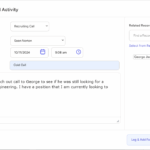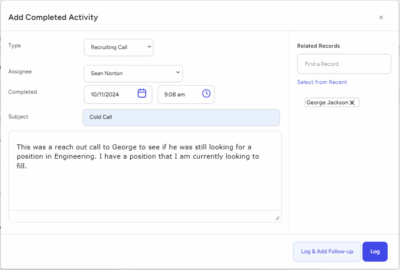In today’s competitive talent market, agency recruiters and search consultants face numerous challenges as they strive to find the best candidates for their clients. From sourcing hard-to-find talent to managing client expectations and keeping candidates engaged, recruiters are tasked with navigating a complex landscape while maintaining efficiency and delivering results.
For many, the solution to overcoming these hurdles lies in recruiting software. The right software can streamline recruiting processes, reduce administrative burdens, and help recruiters focus on what matters most: finding and engaging the right talent. In this article from Top Echelon Recruiting Software, we’ll explore some of the most common hiring challenges faced by agency recruiters and search consultants and explain how recruiting software can help overcome them.
The Common Hiring Challenges Agency Recruiters Face
Before diving into how recruiting software can help, let’s take a look at some of the most common hiring challenges that recruiters encounter daily:
- Sourcing Quality Candidates: With increasing competition for top talent, finding qualified candidates quickly is one of the biggest challenges. Recruiting agencies often have to search through various sources—job boards, social media, professional networks, and databases—to find the right candidates for a given role.
- Managing Large Volumes of Applicants: For many roles, recruiters receive an overwhelming number of applications. Sifting through resumes, tracking candidates, and keeping notes on interviews and feedback can quickly become cumbersome without the right tools.
- Reducing Time-to-Hire: The time it takes to fill a position can have a significant impact on the client’s business and the recruiter’s success. Long hiring processes can lead to candidates dropping out, missed deadlines, and dissatisfied clients.
- Engaging Passive Candidates: Passive candidates—those who aren’t actively looking but might be open to new opportunities—are often the most sought-after talent. However, reaching and engaging passive candidates can be difficult without the right approach and tools.
- Client Communication and Collaboration: Managing client relationships and keeping clients informed about the progress of their job orders can be challenging, particularly when dealing with multiple clients and roles at once. Clients expect transparency and timely updates, but manual communication can be slow and prone to miscommunication.
- Managing Candidate Experience: Creating a positive candidate experience is crucial, but it can be difficult to maintain a high level of personalization and responsiveness when dealing with large volumes of candidates.
- Ensuring Compliance and Data Security: Recruiting involves handling sensitive candidate information, and with regulations such as GDPR, recruiters must ensure they are compliant with data privacy laws. Managing compliance manually can be risky and time-consuming.
Recruiting software addresses these challenges by automating key tasks, improving communication, and providing tools to streamline the entire hiring process.
1. Sourcing Quality Candidates: Leverage Multi-Channel Sourcing and AI-Powered Search
One of the biggest challenges for recruiters is finding high-quality candidates quickly, especially for specialized roles or in competitive industries. Recruiting software helps overcome this challenge by integrating multi-channel sourcing tools and AI-powered search features.
How Recruiting Software Helps:
- Multi-Channel Sourcing: The best recruiting platforms allow recruiters to source candidates from multiple channels in one place. This includes job boards, social media, referral systems, and internal databases. By integrating these channels into one platform, recruiters can widen their reach without having to manually post jobs or search for candidates across different platforms.
- AI-Powered Candidate Matching: Advanced recruiting software uses artificial intelligence (AI) to match candidates to job descriptions based on their qualifications, skills, and experience. AI tools can analyze large volumes of data to suggest the most suitable candidates for a role, making the sourcing process faster and more accurate.
- Candidate Search and Filtering: Recruiting software often includes powerful search tools that allow recruiters to filter candidates based on specific criteria, such as location, skills, or job title. These tools help recruiters quickly narrow down their talent pool and focus on the most relevant candidates.
By automating and streamlining the sourcing process, recruiting software allows recruiters to find high-quality candidates more efficiently, reducing the time and effort needed to fill positions.
2. Managing Large Volumes of Applicants: Applicant Tracking System (ATS) Efficiency
Managing large volumes of applicants is a challenge that many recruiters face, particularly for high-demand roles. Keeping track of hundreds of resumes, interview notes, and feedback can be overwhelming without the right systems in place. An Applicant Tracking System (ATS) is a core feature of most recruiting software platforms and is specifically designed to solve this problem.
How Recruiting Software Helps:
- Centralized Candidate Database: An ATS stores all candidate data in a centralized database, allowing recruiters to easily access resumes, contact details, interview notes, and feedback in one place. This eliminates the need for manual tracking and ensures that no candidate slips through the cracks.
- Automated Resume Parsing: Resume parsing tools automatically extract relevant information from resumes and populate candidate profiles in the ATS. This saves recruiters from manually entering data and ensures that candidate profiles are complete and accurate.
- Pipeline Management: An ATS allows recruiters to visualize and manage their candidate pipeline, making it easy to see where each candidate stands in the hiring process. Recruiters can move candidates through different stages (e.g., screening, interviews, offer) with a few clicks, reducing administrative work and ensuring that candidates progress smoothly.
- Bulk Actions: Many ATS platforms include bulk action features that allow recruiters to send emails, update candidate statuses, or schedule interviews for multiple candidates at once. This reduces repetitive tasks and speeds up communication with large groups of candidates.
By using an ATS to manage large volumes of applicants, recruiters can stay organized and ensure that every candidate receives the attention they deserve without being overwhelmed by administrative work.
3. Reducing Time-to-Hire: Streamlining Workflows and Automating Tasks
Time-to-hire is a key metric that directly impacts both client satisfaction and recruiting success. Delays in the hiring process can lead to missed opportunities and dissatisfied clients. Recruiting software can help reduce time-to-hire by automating repetitive tasks and streamlining workflows.
How Recruiting Software Helps:
- Automated Job Posting: Instead of manually posting job openings to various job boards, recruiting software can automate the process, publishing job ads to multiple platforms simultaneously with just one click. This speeds up the sourcing process and gets your job in front of more candidates faster.
- Automated Interview Scheduling: Coordinating interviews is one of the most time-consuming tasks in recruitment. Recruiting software with automated scheduling tools allows candidates and clients to select available time slots, reducing the back-and-forth required to finalize interview times.
- Pre-Screening Automation: Automated pre-screening tools can evaluate candidate resumes or application forms based on pre-set criteria. This allows recruiters to quickly identify which candidates meet the minimum qualifications and move them to the next stage, saving time on manual screening.
- Automated Communication: Keeping candidates informed about their application status is critical to keeping the process moving. Recruiting software can automate status updates, interview reminders, and follow-up emails, ensuring that candidates receive timely communication without recruiters needing to manually send each message.
By automating these routine tasks, recruiting software accelerates the hiring process, reducing time-to-hire and helping recruiters meet client expectations.
4. Engaging Passive Candidates: CRM Tools for Building Relationships
Passive candidates—those not actively seeking a new job—are often some of the most valuable talent in the market. However, engaging passive candidates requires a different approach than working with active job seekers. Recruiting software with built-in Candidate Relationship Management (CRM) tools can help recruiters nurture long-term relationships with passive candidates.
How Recruiting Software Helps:
- Nurturing Talent Pools: CRM tools allow recruiters to segment candidates into talent pools based on skills, industry, or seniority. This enables recruiters to maintain engagement with passive candidates by sending them personalized updates about relevant opportunities or industry news.
- Automated Follow-Ups: For passive candidates, timely communication is key to keeping them engaged. CRM tools can automate follow-up reminders and outreach campaigns, ensuring that recruiters stay in touch with candidates even if they’re not immediately looking for a new role.
- Personalized Messaging: Recruiting software can help recruiters send personalized messages at scale, allowing them to craft communications tailored to each candidate’s interests and career goals. This personalized approach helps build trust and strengthens relationships with passive candidates.
By leveraging CRM tools, recruiters can engage passive candidates more effectively, ensuring they remain interested when the right opportunity arises.
5. Managing Client Communication and Collaboration: Real-Time Updates and Client Portals
Managing client relationships is critical for agency recruiters. Clients expect timely updates on the progress of their job orders, as well as transparency and collaboration throughout the recruitment process. Without the right tools, manual communication with clients can lead to delays, miscommunication, and frustration.
How Recruiting Software Helps:
- Client Portals: Many recruiting software platforms offer dedicated client portals where clients can log in, view candidate profiles, track the progress of their job orders, and leave feedback. This provides real-time transparency, reducing the need for constant status update emails and ensuring that clients feel engaged in the process.
- Collaborative Tools: Recruiting software enables real-time collaboration between recruiters and clients. Clients can leave notes on candidate profiles, request interviews, or provide feedback directly through the platform. This streamlines communication and ensures that client input is captured quickly and accurately.
- Automated Reporting: Recruiting software allows recruiters to generate custom reports for clients, detailing key metrics such as time-to-fill, candidate submissions, interview outcomes, and more. These reports help clients stay informed and demonstrate the value that the recruiting agency provides.
By improving client communication and collaboration, recruiting software helps build stronger relationships, increases client satisfaction, and reduces the likelihood of miscommunication.
6. Enhancing Candidate Experience: Automation for Consistent Communication
Creating a positive candidate experience is essential for agency recruiters looking to build long-term relationships with candidates and strengthen their reputation in the market. However, with a large volume of candidates to manage, it can be difficult to provide consistent, personalized communication.
How Recruiting Software Helps:
- Automated Email Campaigns: Recruiting software allows recruiters to create automated email campaigns that send personalized updates to candidates at key points in the hiring process. For example, candidates can receive automatic confirmation emails when they apply, follow-up reminders after interviews, and status updates as they move through the recruitment pipeline.
- Self-Service Candidate Portals: Candidate portals give candidates direct access to their application status, interview schedules, and required documents. This empowers candidates to manage their own process, reducing the need for manual communication while keeping them engaged and informed.
- Feedback Collection: Many recruiting platforms include tools for collecting feedback from candidates about their experience. This allows recruiters to identify areas for improvement and ensure that candidates feel valued, even if they aren’t selected for a role.
By automating communication and providing candidates with the tools they need to manage their application process, recruiting software enhances the candidate experience, leading to higher engagement and stronger relationships.
7. Ensuring Compliance and Data Security: Automating Compliance Management
Recruiters handle sensitive personal data, and ensuring compliance with data privacy laws—such as GDPR in Europe—is a critical responsibility. Managing compliance manually can be complex and risky, but recruiting software provides built-in tools to ensure that recruiters adhere to legal requirements.
How Recruiting Software Helps:
- Automated Consent Management: Recruiting software can automatically request and track candidate consent for data processing. This ensures that all data is collected and stored in compliance with GDPR and other data protection regulations.
- Data Retention Policies: The software can automate data retention policies, ensuring that candidate information is deleted or anonymized after a certain period, in line with legal requirements.
- Secure Document Storage: Recruiting software provides secure storage for sensitive candidate documents, such as resumes, references, and contracts. Data encryption and access controls help protect candidate information from unauthorized access.
By automating compliance management, recruiting software helps protect agencies from legal risks and ensures that candidate data is handled responsibly and securely.
Conclusion
Agency recruiters and search consultants face a wide range of challenges when it comes to sourcing, engaging, and placing candidates. However, with the right recruiting software in place, many of these challenges can be overcome. From automating routine tasks like candidate sourcing and communication to improving client collaboration and ensuring compliance, recruiting software empowers recruiters to work more efficiently, build stronger relationships, and deliver better results for both candidates and clients.
As competition for top talent intensifies and the recruitment landscape becomes more complex, investing in advanced recruiting software is no longer a luxury—it’s a necessity. By leveraging the power of automation and streamlined processes, agencies can overcome common hiring challenges and position themselves for long-term success in an increasingly competitive market.








